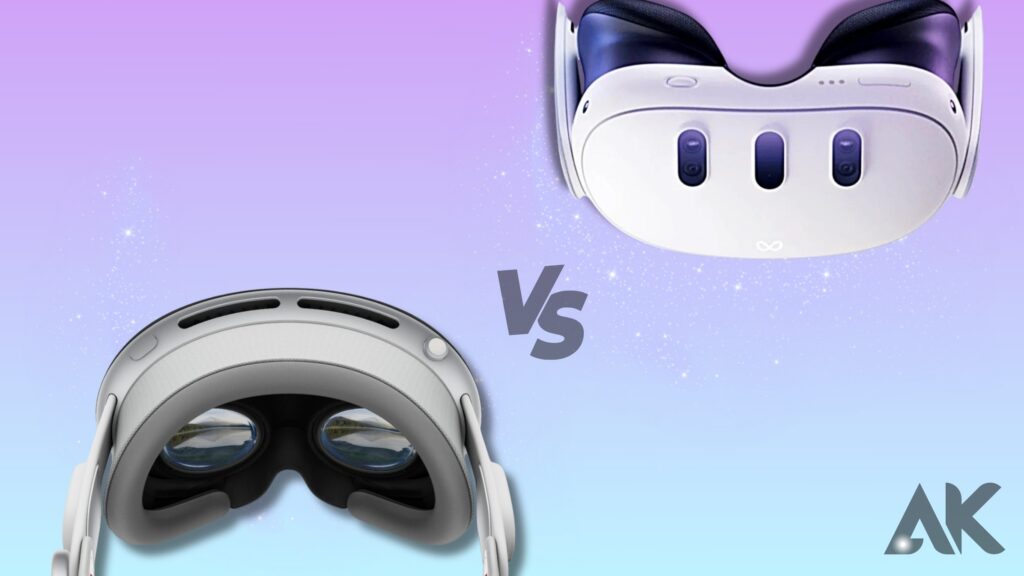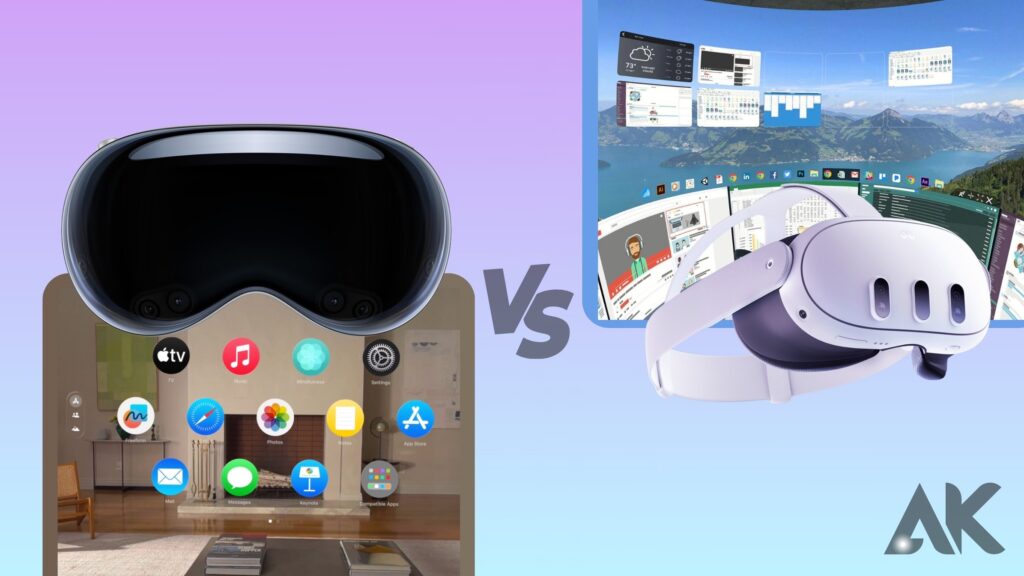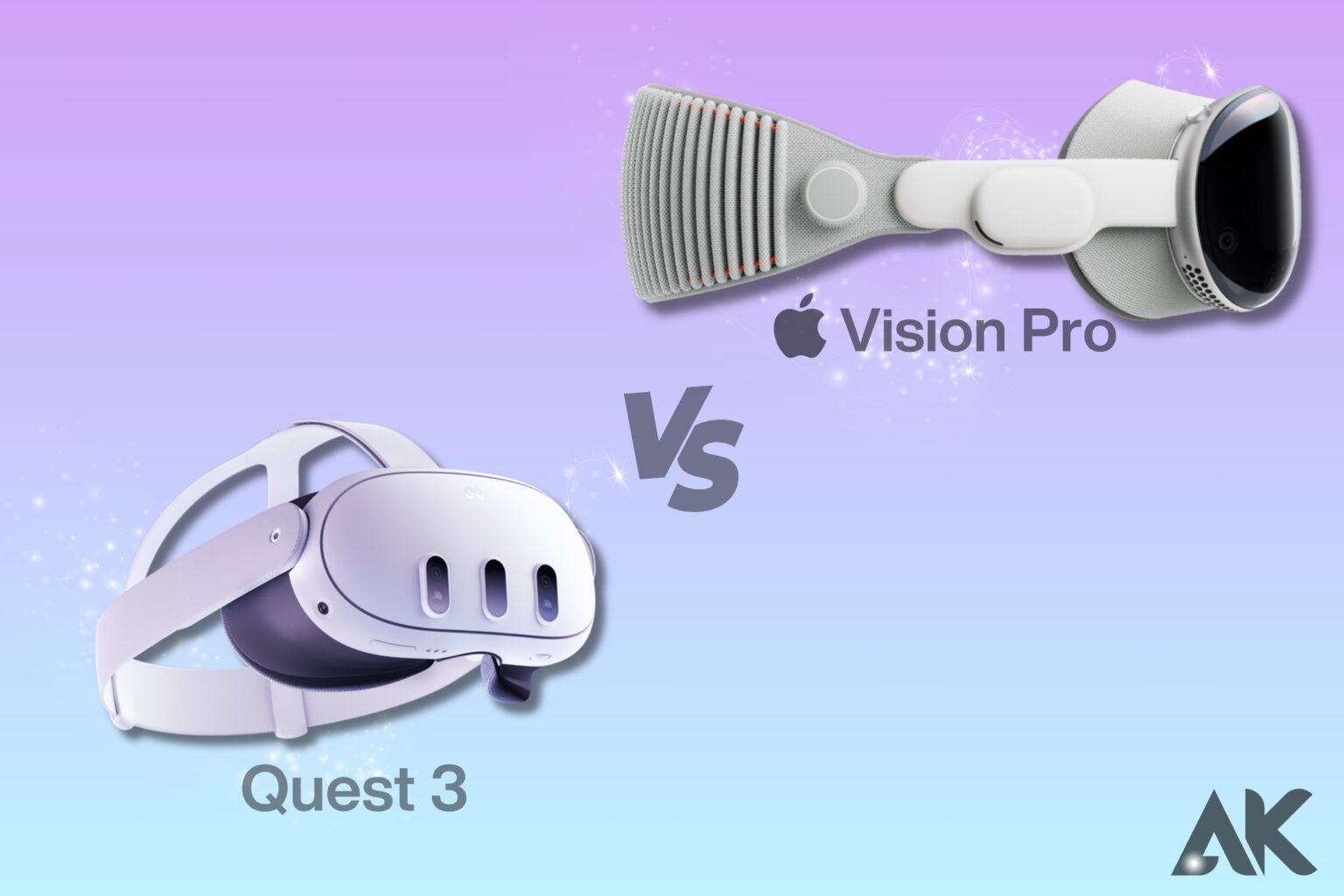As we examine the Quest 3 and Apple Vision Pro Resolution, we will take you on a tour of their breathtaking displays as we compare and contrast their features, specs, and performance. See how these revolutionary technologies are expanding the limits of what is possible in terms of visual quality, from sharp details to vivid colours. There is a table that follows.
| Apple Vision Pro | Meta Quest 3 | |
| Resolution (per eye) | 23MP per eye, roughly 4K resolution | 2,064 x 2,208 pixels per eye |
| Display Type | Micro-OLED | Dual LCD, Pancake lenses |
| Storage | 1TB / 2TB / 4TB | 128GB / 512GB |
| Connectivity | Wi-Fi and Bluetooth | Wi-Fi 6E, Bluetooth 5.2 |
| Battery Life | 2 hours (estimated) | 2.4 hours gaming |
| Tracking Technology | LEDs and infrared cameras | N/A |
| Audio | Two speakers with spatial audio | Improved near-field speakers |
| Weight | ~1 pound (453 grams) | 515g |
| Refresh rate | 90 Hz | 120Hz |
| Processor | Apple M2 + Apple R1 | Qualcomm Snapdragon XR2 Gen 2 |
| RAM | Unknown | 8GB |
Apple Vision Pro vs Meta Quest 3: Design and Comfort

Meta is indeed “cheaped out” when it comes to design, as my Quest 3 can attest.
Its portability is a major feature, especially when compared to its predecessor, the Quest 2. I can assure you that the Vision Pro’s excessive weight is not a problem with the Quest 3, as many journalists and influencers have complained.
The Quest 3’s white nylon and polyester straps, nevertheless, are rather weak. While I was fiddling with the headset’s settings, I pulled the strap out of its clasp by mistake. Even if I fixed it, this doesn’t bode well for its long-term viability.
In addition to Quest 3, I strongly suggest purchasing an Elite Strap. Yes, it’s a pain to shell out $500 for an attachment, but the Elite Strap secures the Quest 3 to your head, making it perfect for fast-paced games like Beat Sabre.
As discussed before, the Vision Pro is known for its uneven weight distribution. MKBHD, a YouTuber, said he couldn’t see himself in it for too long. The majority of the Quest 3’s construction is plastic, which contributes to its being very lightweight. The Vision Pro, in contrast, is very cumbersome due to its metal and glass construction.
According to CNET, Apple sells a product called the Dual Loop band that helps enhance the balance of the Vision Pro, similar to Meta’s Elite Strap.
However, the Vision Pro comes with the Dual Loop band instead of the Elite Strap.
And lastly, the Vision Pro is the most attractive one, in my opinion. The three “eyes” in Meta Quest 3 make me think of an insect that spins webs. Bleugh.
Display and optics
Whenever it comes to sharing technical details, Apple is frequently picky. Take the iPhone as an example; it only ever mentions the estimated duration, never the battery capacity. Those subtleties are irrelevant if the owners are satisfied. However, knowing this would help make comparisons.
A few customers have already voiced their dissatisfaction with the Vision Pro, claiming that the field of vision is too narrow. The term “field of vision” (FoV) refers to the portion of your field of view that the virtual reality headset’s display occupies, with the remaining space appearing as dark edges.
On the horizontal plane, the human vision field extends over 200 degrees, which is quite wide. Much of what we see, however, is in the outer corners of our eyes, which allow us to detect motion but not fine detail. The range of 100 to 120 degrees is more crucial since it allows one to perceive depth. Our eyes naturally wander around the page as we read, as our vision is strongest in the centre at 60 degrees.
For the most lifelike virtual reality experience, a wide field of vision is ideal for a VR headset. You may not even see the screen’s edges thanks to the Quest 3’s 110-degree horizontal field of view. There have been reports of a black border around the display on the Vision Pro from reviewers who are experienced with virtual reality headsets, such as YouTuber Marques Brownlee. Some people don’t mind, but everyone thinks the field of view is superior in Meta’s Quest 3.
All three headsets have decent central clarity, although the Vision Pro from Apple has double the resolution of the Quest 3. In situations where you need to read tiny text or examine still photos closely, that becomes relevant. It’s a major selling point for the Vision Pro and a major contributor to its expensive price tag.
Compared to the Quest 3’s LCD panels, the Vision Pro’s micro-OLED displays have a far larger dynamic range. A few drawbacks are associated with OLED technology, however. Virtual reality veterans have noticed some motion blur as items start to move around on the Vision Pro’s screen due to its significant persistence.
While Meta’s Quest 3 does a better job in certain respects, the Vision Pro generally has top-tier picture quality compared to other headsets.
Passthrough cameras and mixed reality
The pass-through cameras are the main feature of both headsets when it comes to mixed reality. The front of the Meta Quest 3 headgear has cameras, while the middle pill-shaped hole houses a depth sensor. Activating the cameras allows you to view your immediate surroundings, bringing the virtual reality experience to life via your headset.
In well-lit environments, the cameras provide respectable sharpness and accurate colour reproduction. Having said that, loudness and graininess are issues in poorly lit spaces. You will undoubtedly notice if it is your only focus. Having other things to look at in a mixed reality encounter can help take your mind off of the dim lighting.
Meta places a lot of emphasis on mixed reality in their promotion of Quest 3. It gets its dedicated area on the main website. Because of the upgraded camera in The Quest 3, it is a huge improvement over The Quest 2. While you may not be interested in watching TV or reading through it, MR has some impressive instances in games like First Encounter, I Expect You To Die: Home Sweet Home, and Drop Dead: The Cabin.
The Vision Pro’s cameras and mixed reality capabilities are now shrouded in mystery. There are a total of twelve microphones, five sensors, and cameras on the gadget. Among them are motion sensors for detecting eye and head movements and LIDAR cameras for collecting 3D data.
Performance and software
With 8 GB of RAM and the Snapdragon XR2 Gen 2, the Meta Quest 3 is now the most powerful standalone virtual reality headset on the planet. It should be able to connect to anything with the greatest number of features and speeds since it employs Wi-Fi 6E and Bluetooth 5.2 for communication.
In addition to being more efficient generally, our evaluation found that the Snapdragon XR2 Gen 2 offered much superior gaming performance. Video pass-through is available with a delay of 12 ms. No matter what you’re playing or using it for, it looks better and feels smoother than most other standalone VR headsets on the market.
The headset’s software is based on Android and developed by Meta. It is called a quest. While there is room for development in Quest, the programme is generally dependable and simple to work with. As we said in the assessment, the mixed reality setup procedure greatly simplified formerly laborious tasks, such as room setting.
Apple has always done great with software
The brains behind the Apple Vision Pro are Apple’s VisionOS. In our testing, we found that it closely mimics the look and feel of an iOS device, so it should be easy for long-time Apple fans to get to know it. Spatial video and gesture controls were successful elements, even though our sample size was small and there were no games. The Apple Vision Pro likely uses a combination of the M2 and R1 chipsets, which is why it does that.
A Macbook-level CPU, the former will almost certainly outperform the Snapdragon XR2 Gen 2 in benchmarks. The latter is purpose-built to handle and process the continuous data stream produced by the many sensors, cameras, and microphones. Because of our limited familiarity with the Apple Vision Pro, we are unable to provide an accurate assessment of its capabilities. But its hardware seems better on paper, and Apple has a track record of making great software. Despite Meta Quest 3’s larger game library, the Vision Pro is still a better bet for excitement.
Apple Vision Pro vs Meta Quest 3: Apps and Games

With the 2016 release of the Oculus Rift, the first consumer device in the Quest series, it’s no surprise that this line of headsets is more established. So, for quite some time, developers have been creating games just for the Quest platform.
Additionally, I don’t often use Quest, even though it offers an enormous library of games. After I’ve played a game that I like (like the new I Expect You to Die game), it’s hard to find another one that’s just as interesting. I noted in my review that Quest 3 has an abundance of excellent VR games, but there are very few augmented reality games.
Given that this issue has persisted in the Quest queue for years, consider the enormous challenge the Vision Pro, a brand-new mixed-reality headset, faces.
The good news is that Apple is streamlining the process by which developers working on iOS devices may transfer their applications and games to the Vision Pro. To be successful, however, the Vision Pro will need incredible native Vision Pro software—apps built to use its state-of-the-art hand-and-eye tracking.
With Vision Pro, Apple has unveiled 600 new applications. Based on what DigitalTrends has to say, the 250 games available on Apple Arcade are better suited to a big-screen experience than anything immersive.
Remember that Vision Pro won’t feature Netflix and YouTube native applications like Quest 3. In addition, I have found that watching YouTube and Netflix on the Quest 3 creates an incredible atmosphere similar to that of a large home theatre.
Conclusion
The Apple Vision Pro Resolution and Meta Quest 3 are two VR headsets that offer stunning visuals. The Vision Pro has a resolution of 23 MP per eye, 4K resolution, and uses micro-OLED displays with dual LCD and pancake lenses. The Quest 3 has a lighter design, but the white nylon and polyester straps are flimsy. The Elite Strap is recommended for a more snug fit.
The Vision Pro has a smaller field of view (FoV) than the Quest 3, which is ideal for depth perception. The Vision Pro also has better central clarity, but the Quest 3 has a black border around the display. Despite these differences, the Vision Pro’s image quality is among the best for any headset, but Meta’s Quest 3 wins in some areas.
FAQS
What is the resolution of the Apple Vision Pro?
A top-notch screen is available on the Apple Vision Pro. iFixit’s second headset deconstruction video (and blog) reveals this as the main finding: the headset’s two MicroOLED panels have the highest pixel density to date, measuring 3,386 pixels per inch (ppi).
Will Quest 3 have a better resolution?
With a maximum refresh rate of 90 Hz and two panels measuring 1832 × 1920 pixels each, the Meta Quest 2 is a sight to see. For a more detailed image, the Meta Quest 3 boosts the resolution to 2064 x 2208 pixels and improves the refresh rate to 120 Hz.
What is the eye resolution of Quest 3?
2064×2208 per eye
The display resolution of Quest 3 is greater than that of Quest 2 (1832 x 1920 vs. 2064 x 2208 per eye). A less obvious screen-door effect and crisper images are the results of this. Lenses: Pancake lenses, unlike Quest 2’s Fresnel lenses, provide more uniform clarity over the whole field of vision in Quest 3.

